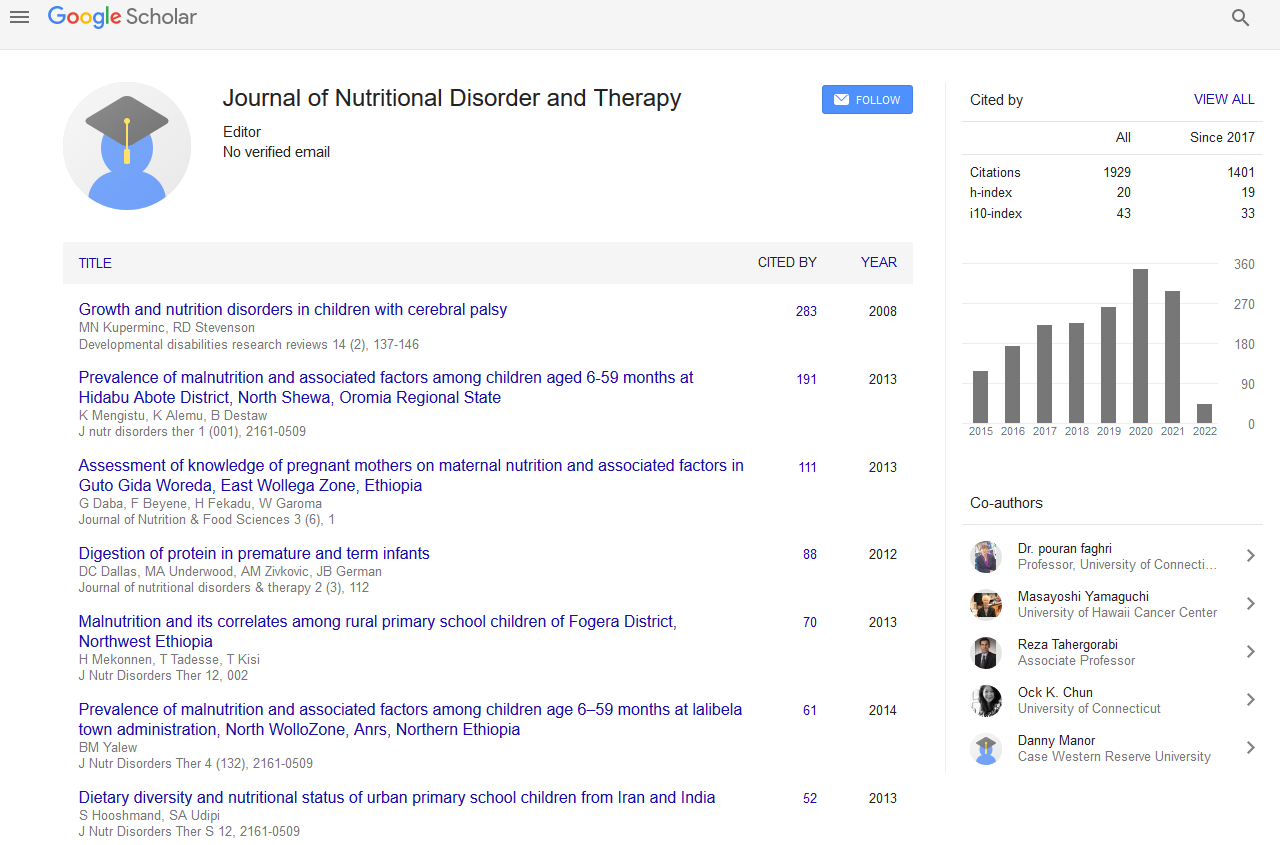Indexed In
- Open J Gate
- Genamics JournalSeek
- Academic Keys
- JournalTOCs
- Ulrich's Periodicals Directory
- RefSeek
- Hamdard University
- EBSCO A-Z
- OCLC- WorldCat
- Publons
- Geneva Foundation for Medical Education and Research
- Euro Pub
Useful Links
Share This Page
Journal Flyer

Open Access Journals
- Agri and Aquaculture
- Biochemistry
- Bioinformatics & Systems Biology
- Business & Management
- Chemistry
- Clinical Sciences
- Engineering
- Food & Nutrition
- General Science
- Genetics & Molecular Biology
- Immunology & Microbiology
- Medical Sciences
- Neuroscience & Psychology
- Nursing & Health Care
- Pharmaceutical Sciences
Nutritional characterization of Sicilian durum wheat for cuccia preparation
JOINT EVENT: 13th International Congress on Advances in Natural Medicines Nutraceuticals & Neurocognition & 14th International Conference on Clinical Nutrition
July 27-29, 2017 Rome, Italy
Rosaria Bognanni, Antonella Pagliaro, Salvatore Scandurra and Maria Grazia Melilli
University of Foggia, Italy
Posters & Accepted Abstracts: J Nutr Disorders Ther
Abstract:
Statement of the Problem: In recent years, cereals have been rediscovered by the consumers and with them, local dishes such as cuccia, a Sicilian durum wheat soup, representing a good source of nutraceuticals and oligoelements are also discovered. In fact the use of whole grains of wheat allows the inclusion in the diet of protein, carbohydrates, dietary fiber, vitamins and minerals. The aim of the work was the chemical characterization of Sicilian durum wheat cultivars to be allocated for the production of cuccia. Methodology & Theoretical Orientation: The whole kernels of 4 varieties of durum wheat (2 modern Simeto and Archangel and two traditional Russello and Timilia), were subjected to chemical analysis: ashes, proteins, fat, carbohydrates, mineral content (Na, Fe K, Ca, Mg, Mn) vitamins A and E content. Findings: On average of the 4 accessions, the ash content was equal to 1.68, the proteins and fats 12.9 and 1.98 g 100 g-1 DM. The content in Vitamin A was 0.5 μg 10-2 g DM and Vitamin E 60.7 μg 10-2 g DM. The cv Russello showed the highest content in protein (13.6 g 100 g-1 DM), manganese (62.5 mg Kg-1 DM) and Vitamin A (0.6 μg 10-2 g DM). Conclusion & Significance: The cuccia is a good source of vitamins and minerals. Among the accessions �??Russello�?�, different from modern varieties, could be devoted for cuccia preparation. It also important to note the difference in the nutritional composition between the whole wheat grains, used for the preparation of Cuccia, and semola, purified fraction used for the preparation of bread and/or pasta without the biomolecules naturally occurring in the pericarp and in aleuronic fraction of the kernel.
Biography :
Rosaria Bognanni is a Food Technologist with a PhD in Science and Technology (formerly Food Biotechnology) with title of dissertation: "Durum wheat: compositional, nutritional and technologic aspects for innovative food production”. Since 2004, she has been working as Researcher at the Stazione Consorziale Sperimentale di Granicoltura per la Sicilia, a Governmental Institute of Agronomic Research, mainly working with modern and ancient grains. Currently, she is working at the CNR–ISAFOM to research an innovative method to produce fortified bread made with antioxidant and lowering-cholesterol activities, using typical plants of the Mediterranean basin, known for its beneficial effects on human health.


